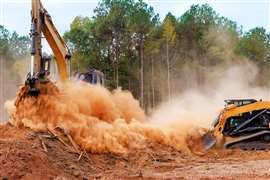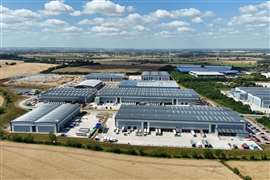Latin America regional report: Infrastructure investment
19 July 2011

Large infrastructure projects and increasing private investment are boosting the construction sector’s momentum throughout Latin America. Helen Wright reports.
South America will be a central force behind the forecast +3% growth in global construction output this year, according to IHS Global Insight, and rising public budgets coupled with the start of large infrastructure projects indicate that the region's construction growth will continue.
Brazil is leading the construction market's strong performance in Latin America, spearheaded by a drive for new infrastructure. Overall, preparation for the World Cup in 2014 and Olympic Games in 2016, combined with Brazils' growing oil sector, are driving a forecast US$ 141 billion infrastructure spend by 2020, figures from IHS Global Insight show.
According to the Brazilian Construction Chamber, the industry is expected to grow +6% this year as a direct result of projects relating to the upcoming sporting events together with Brazil's second Growth Acceleration Plan (PAC II).
For the World Cup and Olympic Games alone, Brazil will spend up to US$ 63 billion on new infrastructure and improvements to existing facilities. Up to US$ 48 billion is needed to prepare for the World Cup, while around US$ 15 billion will be invested in Rio De Jeneiro ahead of the 2016 Olympics.
Private investment
Meanwhile, private investments under Brazil's PAC II programme are expected to reach more than US$ 105 billion by 2014 - accounting for at least 18% of the total US$ 574 billion earmarked by the government for infrastructure projects by 2014.
Investments in Brazil's roads will also be a priority for this year, and the government plans to launch concession bids worth
US$ 3.6 billion for more than 1246 miles (2005 km) of roads across the country.
The PAC II programme also envisages huge investment in Brazil's railways. Approximately US$ 26.3 billion has been earmarked for rail projects by 2014, including expanding the current railway network by more than 2796 miles (4450 km) throughout the country.
Increased budgets
Meanwhile in Argentina, construction has been identified by President Cristina Fernandez de Kierchner as one of the ten priority areas for development.
Argentina's construction sector was worth US$ 14.4 billion in 2010, according to IHS Global Insight, which forecasts the country's total construction spend to increase at a rate of +3.8% in 2011 and 2012, led by investment in the country's non-residential construction sector.
In Mexico, too, growth in the industrial and agricultural sectors is fuelling demand for better roads throughout the country, and the government plans to invest over US$ 4.8 billion this year to construct and upgrade over 2610 miles (4200 km) of highways.
The Mexican Construction Industry Chamber expects the country's construction sector to grow by +2.6% this year, but financial institutions such as Santander and Skotiabank have forecast higher growth of around +4.5%.
Construction growth in Chile, meanwhile, is increasing for different reasons. Reconstruction projects from 2010's devastating earthquake in the Atacama region are driving expected +10.8% growth in the country's construction sector this year, according to the Chilean Construction Chamber.
The private sector's involvement is also increasing, with over
US$ 73 billion expected to be invested, mostly in mining and energy projects, by 2014, according to the Association of Equipment Manufacturers (AEM).
Meanwhile, around US$ 16 billion in private investment expected in the whole of Chile this year alone - a +60% increase on last year, according to AEM.
Chile's government has also budgeted more than US$ 1.5 billion to improve the city's capital transport system, Transantiago, according to AEM. At least 64% of the investments will be used for the construction of over 67.7 miles (109 km) of new segregated lanes by 2015.
Similarly, strong growth is forecast for Peru's construction sector. The industry is expected to grow by +12% this year, according to AEM, driven by new building work in the residential and commercial sectors.
Peru's Finance and Economic Ministry has prioritised 30 infrastructure projects worth at least US$ 3 billion for 2011, including the expansion and upgrade of ports in Iquitos, Yurimaguas, and Pisco.
The Peruvian government has also negotiated loans totalling US$ 1.5 billion for 2011 from the Andean Development Corporation, including US$ 300 million for Lima's electric train system and US$ 200 million for road construction projects.
And international interest from private companies is also growing in Peru. Spanish contractor Acciona, for example, plans to increase its footprint in Latin America by opening an engineering subsidiary in the country this year.
Energy demands
This snapshot of construction investment in some of Latin America's major economies paints a picture of solid medium-term growth. However, the outlook for the longer term hinges to some extent on the region's ability to meet its ever increasing energy needs, and to diversify its power generation sources.
The Latin America Energy Organisation (LAEO), for example, has stressed that energy plays a dominant role in the future of South America and there is a need for the region's governments to develop secure and reliable energy sources.
Diversity is key - about 70% of the region's current energy mix comes from hydrocarbons, mostly imported, making Latin American countries that don't produce their own oil, gas or coal vulnerable to the impact of volatile prices.
While some Latin American countries that are rich in energy resources will benefit from the global rise in commodity prices, such as oil exporters Mexico, Colombia, Ecuador and Venezuela, around 40 million people in the region lack access to electricity, and fuel imports consume a growing percentage of smaller countries' budgets.
Hydropower
South American countries are considering their options - Argentina, for example, deems nuclear energy a prime industry to enhance its national development plans and avoid the risks of blackouts or energy rationing.
The LAEO, meanwhile, estimates that Central America has the potential to develop over 23.8 GW of hydroelectric power in the future.
Indeed, several large hydroelectric projects are currently underway in Latin America. The Belo Monte hydroelectric dam on the Xingu River in the Amazon, for example, was approved by the Brazilian government on 1 June this year.
Built by the Norte Energia consortium, which is led by state-run utility Eletrobras Chesf (49%), the US$ 17 billion,
11200 MW project involves the construction of a 3.8 mile (6.1 km) wide dam.
The Brazilian government has said the hydroelectric plant is crucial to provide power to the country's fast-growing economy. Similarly, Chile's government says it must triple its energy capacity in 15 years, but the country has no domestic oil or natural gas resources and imports 97% of its fossil fuels.
The US$ 7 billion, 2700 MW HidroAysén Project involving the construction of five hydroelectric power stations on the Baker and Pascua rivers in Aysen, a remote region in Chile's southern Patagonia state, was approved in May.
The project is a joint venture between Endesa Chile, which is majority-owned by Spanish energy group Endesa, and privately-owned Chilean utility company Colbún.
The drive for energy independence is fuelling construction growth in Latin America. Indeed, from relatively medium-term opportunities such as Brazil's upcoming international sporting fixtures, to long-term energy projects that will themselves sustain the region's economic and industrial expansion, the outlook for the region's construction sector is very positive.




